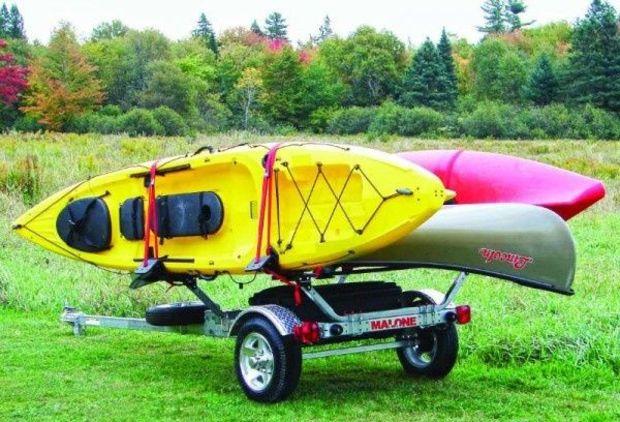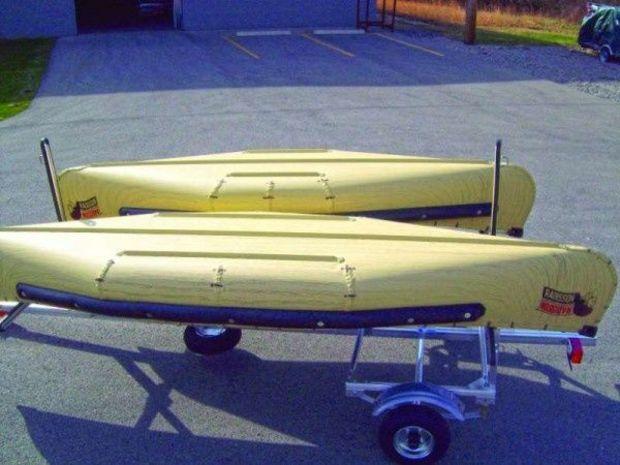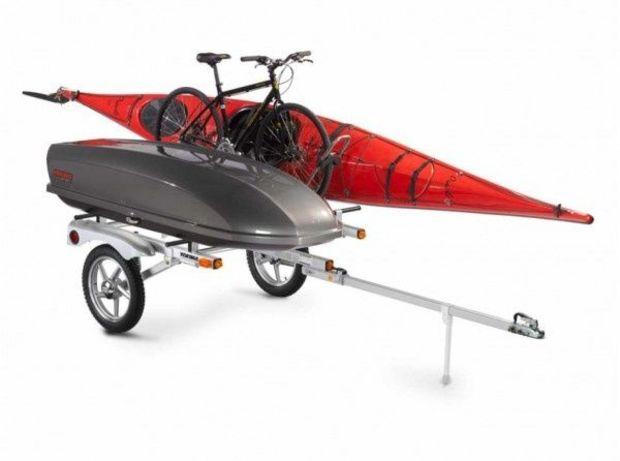There comes a time in our lives when a once-routine chore requires a much bigger adrenaline boost. For me it was two, actually. First, hopping out of the truck bed required about as much thinking as opening a beer. Second nature, done without planning or concentration. An epic pratfall, however, one that luckily ended without injury, has now forced me to slow down. I mean the truck bed dismount, not popping the top on a cold one. Heaven help me the day that tragedy arrives.
The second chore is racking kayaks on top of the truck cap, which as an outfitter is a regular part of my work week in season. Yet, after tweaking my back deadlifting a beastly 14-foot yak—after four aborted attempts mind you—I knew it was time to rethink this method.
Let’s face it: growing old ain’t for sissies. And though I’m a big fan of the adage, “Age is an issue of mind over matter. If you don’t mind, it doesn’t matter;” I’m also not stupid enough to think I can outrun Father Time. He’s the undisputed champ. But a sedentary existence is a far worse fate. Warren Zevon had it right: I’ll sleep when I’m dead. Ok, that’s a bit dramatic but you take my point.
So instead of wrangling with and cussing out my kayaks, I got smarter, if only a little, and went all-trailer, almost all the time. Though for years I’ve used a Trailex two-bunk aluminum trailer that holds 12 kayaks and has a storage box for a paddle and lifevests for my youth camps, I always have a counselor and campers to load that rig.
Recently, I made the switch to trailering the two or three ‘yaks needed for my guiding business.
My latest rig is a new LoadRite jonboat trailer. I’ve fixed the bunks to run perpendicular instead of running parallel to the tongue as they usually do. This way the ‘yaks rest gunwales down on the bunks. To the tongue I’ve bolted an aluminum toolbox, which used to live in the bed of my old pickup. The box pulls double duty as gear storage and rod holder. My only complaint is this trailer is somewhat heavy compared to an aluminum trailer, but the price was right.
Cartopping still makes sense for many people. For me, nothing squashes the good vibes a great day on the water creates like wrestling with an awkward canoe or kayak. Today’s fishing kayaks are significantly wider and heavier than the recreational style many people used before the sport exploded, so trailering makes even more sense.
Moreover, trailering your rigs is more fuel efficient than having them strapped to the roof since it’s more aerodynamic. Trailering also saves your vehicle’s paint job from being dinged up and bathed in saltwater. Yes, trailers are definitely more expensive, and you have to tag and title them. But the benefits outweigh the hassle, at least for my purposes.
Need more positive benefits of trailering over car topping? How about the peace of mind you get with just a quick glance in the rearview mirror, confirming the kayaks are safe and secure. I don’t miss one bit those days when every bump or thud sent a shiver of mini-panic through my spine that the load was sliding off the roof. Here’s a bonus reason: You can lock and store your fishing machine on the trailer, so making a last-minute fishing trip when the bite is on a no brainer.
Whether you’re an angler, paddler, or some other species of watersports fanatic, there are several innovative companies that make quality equipment to haul your water and fishing toys.
Malone MicroSport XT Trailer

Malone took its popular MicroSport Base Trailer and gave it an upgrade, bundling into the price the three top-selling accessories. The frame is constructed of marine-grade, pre-galvanized steel, making it stout enough to handle 355 pounds and a 20-foot canoe or kayak. At 230 pounds, it is on the heavier side compared to aluminum trailers in the same class. Custom 12-inch aluminum spoke wheels and diamond-plate aluminum fenders, however, give the trailer the curb appeal as well as corrosion resistance.
Other features include:
- Eight-foot tongue is easily retractable, making vertical storage against a wall a snap.
- DOT-approved lighting and bearings.
- Pre-tested electrical system and pre-fitted chassis components.
- Made in the U.S.A.
Trailex Multiple Light Duty Boat Trailer

If you're looking for a small and lightweight trailer to pull more than one kayak, Trailex' SUT-250-M2 is a solid choice. Coming in at only 145 pounds, it has a load capacity of 250 pounds, capable of handling almost any two canoes, kayaks, or even small sailboats. It features two adjustable crossbars, the ends of which have vinyl extrusions to protect you yaks from gouges and scratches.
Other features include:
- Epoxy coated leaf spring suspension that eliminates bumpy rides.
- Aluminum frame that's 50 percent lighter than steel trailers, ideal for hauling boats with a small SUV or crossover.
- Submersible tail lights, safety chain, fenders, rear loading roller, and lift handle.
Yakima Rack and Roll Trailer

Most outdoors people recognize the Yakima name. Meet the company's Rack and Roll Trailer, smartly designed so you can use various Yakima racks to carry everything from kayaks to bikes. It has a 250-pound carrying capacity yet only weighs 150 pounds. Add carpeted custom cradle sets and the center Tower System, which includes mast/sail hangers and is also designed so you can mount an equipment box on top. The strong aluminum construction makes it durable yet lightweight.
Other features include:
- Shock absorbers provide greater stability and gear protection.
- Stores easily in compact upright position with removable wheels and tongue.
- Carrying handle transforms lightweight trailer into a handcart.
- LED trailer lights for years of reliable use.
by Capt. Chris D. Dollar
 Malone took its popular MicroSport Base Trailer and gave it an upgrade, bundling into the price the three top-selling accessories. The frame is constructed of marine-grade, pre-galvanized steel, making it stout enough to handle 355 pounds and a 20-foot canoe or kayak. At 230 pounds, it is on the heavier side compared to aluminum trailers in the same class. Custom 12-inch aluminum spoke wheels and diamond-plate aluminum fenders, however, give the trailer the curb appeal as well as corrosion resistance.
Other features include:
Malone took its popular MicroSport Base Trailer and gave it an upgrade, bundling into the price the three top-selling accessories. The frame is constructed of marine-grade, pre-galvanized steel, making it stout enough to handle 355 pounds and a 20-foot canoe or kayak. At 230 pounds, it is on the heavier side compared to aluminum trailers in the same class. Custom 12-inch aluminum spoke wheels and diamond-plate aluminum fenders, however, give the trailer the curb appeal as well as corrosion resistance.
Other features include:
 If you're looking for a small and lightweight trailer to pull more than one kayak, Trailex' SUT-250-M2 is a solid choice. Coming in at only 145 pounds, it has a load capacity of 250 pounds, capable of handling almost any two canoes, kayaks, or even small sailboats. It features two adjustable crossbars, the ends of which have vinyl extrusions to protect you yaks from gouges and scratches.
Other features include:
If you're looking for a small and lightweight trailer to pull more than one kayak, Trailex' SUT-250-M2 is a solid choice. Coming in at only 145 pounds, it has a load capacity of 250 pounds, capable of handling almost any two canoes, kayaks, or even small sailboats. It features two adjustable crossbars, the ends of which have vinyl extrusions to protect you yaks from gouges and scratches.
Other features include:
 Most outdoors people recognize the Yakima name. Meet the company's Rack and Roll Trailer, smartly designed so you can use various Yakima racks to carry everything from kayaks to bikes. It has a 250-pound carrying capacity yet only weighs 150 pounds. Add carpeted custom cradle sets and the center Tower System, which includes mast/sail hangers and is also designed so you can mount an equipment box on top. The strong aluminum construction makes it durable yet lightweight.
Other features include:
Most outdoors people recognize the Yakima name. Meet the company's Rack and Roll Trailer, smartly designed so you can use various Yakima racks to carry everything from kayaks to bikes. It has a 250-pound carrying capacity yet only weighs 150 pounds. Add carpeted custom cradle sets and the center Tower System, which includes mast/sail hangers and is also designed so you can mount an equipment box on top. The strong aluminum construction makes it durable yet lightweight.
Other features include: